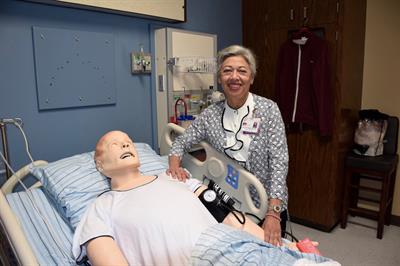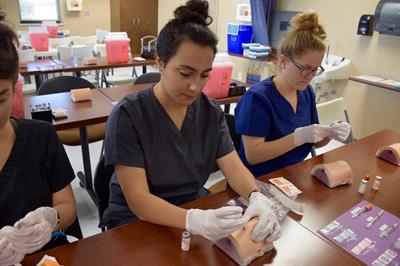
At the UTMB Nursing Interprofessional Simulation Center, “pretend” is a bad word.
So, when first-year School of Nursing students practice intramuscular injections, they use a “task trainer” that looks and feels like an actual piece of flesh—with layers representing skin, fat and muscle.
“Our goal is to make it as real as possible,” said Rachel Kilgore, PhD, RN, director of the Nursing Interprofessional Simulation Center (NISC). “Gone are the days of using an orange to practice insulin injections. When students stick their needles in the task trainers, they get a better feel for what it’s actually like. And it’s a nonthreatening, safe environment—they can make mistakes here.”
UTMB’s NISC opened in 2011 and has so far trained more than 1,500 students in an interprofessional setting. The center’s Smart Hospital, located in the Rebecca Sealy Building, was built in a former surgical unit, providing an environment identical to an active hospital floor with state-of-the-art technologies. From a designated “control room,” nursing faculty can observe and adjust the difficulty level of patient scenarios as students progress in their education. Video-capture software allows for video and audio playback of simulated activity that is used for feedback and evaluation.
Over the past five years, the center has kept pushing forward with innovations to make simulations even more authentic.
“We now have high-fidelity mannequins that can produce blood, sweat and tears, and are programmed to present cases such as stroke and cardia carrest,” said Kilgore. In addition, she makes a point of supplying students with all the same materials they will see in the hospital—from the syringes to the medicine carts. “The only thing we substitute is medication, and even those look real. We color the pills and make them look just like the actual drug.”

School of Nursing student Sophia Hashemi said her first visit to the Smart Hospital during prospective student tours “sealed the deal” when it came to choosing UTMB for her education. The hands-on learning, along with guidance from professors, has given her more confidence when it comes to providing care to real patients.
“Instead of just memorizing and studying, we’ve actually walked through all the steps—starting with gelling in and establishing a therapeutic relationship with the patient,” Hashemi said. “That really prepares us to provide the best care possible to real patients.”
Efforts to keep nursing simulation training as real as possible are paying off, with recent research showing that this type of education is effective. A 2014 study looking at more than 650 students found that substituting high quality simulation experiences for up to half of traditional clinical hours resulted in comparable educational outcomes.
According to Kilgore, simulation training has exploded in the last 10 years, with 3 percent of nursing schools using simulators in 2000—compared to 87 percent by 2010. In addition to SON, UTMB’s School of Medicine and School of Health Professions also use simulation in their education programs. She points to advantages of simulation, which include the ability to ensure students get exposure to a wide variety of patients.
“With clinical rotations, you never know what you’re going to get—you may never get a diabetic patient,” said Kilgore. “But simulation teaching is very efficient because we can cover everything. We can have all students use their critical-thinking skills to take care of a diabetic patient and see what happens when everything goes wrong. It prepares them for anything they could see—it’s not hit or miss.”
Another advantage to simulation is the ability to train more nurses. With limited space in hospitals and clinics, simulation can help ensure students get as much clinical time as they need. And with the forecasted shortfall in health care personnel needed to care for the aging population, Kilgore said simulations are more important than ever. She’s attended conferences around the country to learn about the latest simulator training methods and technologies and bring them back to UTMB.
“In the hospital, it’s all about the patients. But here, it’s all about the students,” said Kilgore. “I’m always thinking about what the students really need and what will be coming down the road for simulation—are we going to do start using virtual environments? Gaming? What are the most innovative ways for them to learn?”
One thing Kilgore knows for sure: the new Health Education Center planned for the UTMB Galveston Campus will bring further innovation and interdisciplinary collaboration. The five-story, 200,000-square-foot facility will include more simulation space and classrooms to accommodate increasing enrollments. It’s scheduled to open in 2019.